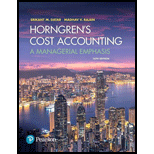
Concept explainers
The following data (in thousands) pertain to 2017:
| Direct materials and supplies purchased on credit | $800 |
| Direct materials used | 710 |
| Indirect materials issued to various production departments | 100 |
| Direct manufacturing labor | 1,300 |
| Indirect manufacturing labor incurred by various production departments | 900 |
| 400 | |
| Miscellaneous manufacturing overhead* incurred by various production departments (ordinarily would be detailed as repairs, photocopying, utilities, etc.) | 550 |
| Manufacturing overhead allocated at 160% of direct manufacturing labor costs | ? |
| Cost of goods manufactured | 4,120 |
| Revenues | 8,000 |
| Cost of goods sold (before adjustment for under- or overallocated manufacturing overhead) | 4,020 |
| Inventories, December 31, 2016 (not 2017): | |
| Materials Control | 100 |
| Work-in-Process Control | 60 |
| Finished Goods Control | 500 |
*The term manufacturing overhead is not used uniformly. Other terms that are often encountered in printing companies include job overhead and shop overhead.
- 1. Prepare an overview diagram of the job-costing system at the University of Chicago Press.
Required
- 2. Prepare journal entries to summarize the 2017 transactions. As your final entry, dispose of the year-end under- or overallocated manufacturing overhead as a write-off to Cost of Goods Sold. Number your entries. Explanations for each entry may be omitted.
- 3. Show posted T-accounts for all inventories, Cost of Goods Sold, Manufacturing Overhead Control, and Manufacturing Overhead Allocated.
- 4. How did the University of Chicago Press perform in 2017?
Want to see the full answer?
Check out a sample textbook solution
Chapter 4 Solutions
Horngren's Cost Accounting: A Managerial Emphasis (16th Edition)
- Miguel Manufacturing Company uses a predetermined manufacturing overhead rate based on direct labor hours. At the beginning of 2023, they estimated total manufacturing overhead costs at $2,352,000, and they estimated total direct labor hours at 7,000. The administration and selling overheads are to be absorbed in each job cost at 15% of prime cost. Distribution cost should be added to each job according to quotes from outside carriage companies. The company wishes to quote for job # 222. Job stats are as follows: Direct materials cost Direct labour cost $173,250 $240,000 500 hours Direct labour hours Special Design Cost Distribution quote from haulage company Units of product produced $8,750 $21,700 400 cartons a) Compute Miguel's Manufacturing Company predetermined manufacturing overhead rate for 2023. b) How much manufacturing overhead was allocated to Job #222? c) Calculate the total cost & quotation price of Job #222, given that a margin of 25% is applied. d) How much was the…arrow_forwardFaced with rising pressure for a $17 per hour minimum wage rate, the farming industry is currently exploring the possible use of robotics to replace some farm workers. The Produce Bot is one such robot; its job is to thin out a field of lettuce, removing the least promising buds of lettuce. By removing these weaker plants, the stronger lettuce plants have more room to grow. Assume the following facts: i (Click the icon to view the information.) While the Produce Bot itself may be in workable condition for up to five years, assume that the farm would view its implementation as a one-year experiment. Requirement Perform a cost-benefit analysis for the first year of implementation to determine whether the Produce Bot would be a financially viable investment if the minimum wage is raised to $17 per hour. (Round your answers to the „bola dallon\ Cost-Benefit Analysis Expected Benefits (Cost Savings): Total expected benefits Expected Costs: Total expected costs Net expected benefit (cost)…arrow_forwardPlease help me with the last entry. The dropdown options are the revenue accounts i can usearrow_forward
- Please help me with this problem!arrow_forwardPlease help me with this problemarrow_forwardPROBLEM 2 On July 1, 2022, LTU Contracting, Inc. purchased a new Peiner SK575 Tower Crane for a total cost of $875,000. The crane has an estimated useful life of five (5) years. For financial reporting (book) purposes, the company utilizes straight line depreciation. For tax purposes, the equipment is depreciated over five years utilizing the 200% declining balance method. A. Prepare a table that computes the book and tax depreciation for each year of the useful life and determine the difference in book value between each method at the end of each year. B. On July 1st, 2025, the company is considering selling the crane for $500,000. Compute what the gain or loss would have been at that time for both book and tax purposes.arrow_forward
 Principles of Cost AccountingAccountingISBN:9781305087408Author:Edward J. Vanderbeck, Maria R. MitchellPublisher:Cengage Learning
Principles of Cost AccountingAccountingISBN:9781305087408Author:Edward J. Vanderbeck, Maria R. MitchellPublisher:Cengage Learning Cornerstones of Cost Management (Cornerstones Ser...AccountingISBN:9781305970663Author:Don R. Hansen, Maryanne M. MowenPublisher:Cengage Learning
Cornerstones of Cost Management (Cornerstones Ser...AccountingISBN:9781305970663Author:Don R. Hansen, Maryanne M. MowenPublisher:Cengage Learning Managerial AccountingAccountingISBN:9781337912020Author:Carl Warren, Ph.d. Cma William B. TaylerPublisher:South-Western College Pub
Managerial AccountingAccountingISBN:9781337912020Author:Carl Warren, Ph.d. Cma William B. TaylerPublisher:South-Western College Pub Managerial Accounting: The Cornerstone of Busines...AccountingISBN:9781337115773Author:Maryanne M. Mowen, Don R. Hansen, Dan L. HeitgerPublisher:Cengage Learning
Managerial Accounting: The Cornerstone of Busines...AccountingISBN:9781337115773Author:Maryanne M. Mowen, Don R. Hansen, Dan L. HeitgerPublisher:Cengage Learning Financial And Managerial AccountingAccountingISBN:9781337902663Author:WARREN, Carl S.Publisher:Cengage Learning,Principles of Accounting Volume 2AccountingISBN:9781947172609Author:OpenStaxPublisher:OpenStax College
Financial And Managerial AccountingAccountingISBN:9781337902663Author:WARREN, Carl S.Publisher:Cengage Learning,Principles of Accounting Volume 2AccountingISBN:9781947172609Author:OpenStaxPublisher:OpenStax College





